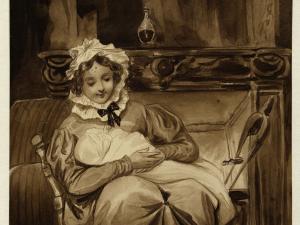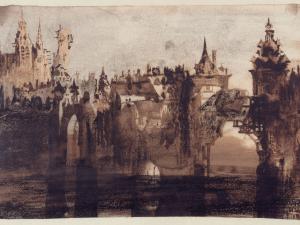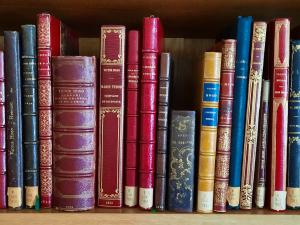Illustrations
Many of Victor Hugo’s characters have taken shape in our imagination through the images created by illustrators who contributed to the 19th-century popularity of illustrated publications. But the poet's writing also inspired painters and sculptors very early on. Thus the iconography of his literary work constitutes a major part of the collections, including paintings, drawings, sculptures and numerous engravings, derived from the illustrated editions held in the library.
The first illustrators of Victor Hugo's work were primarily his friends: Achille and Eugène Devéria, Louis Boulanger, Alfred and Tony Johannot, and Célestin Nanteuil, who were members of the Romantic set. They not only worked on the first illustrated editions, which saw a revival during the Romantic Movement, but also on Victor Hugo’s theatre productions, producing designs for stage costumes and scenery.
Louis Boulanger, who was very close to the poet, also produced watercolours on the themes of The Hunchback of Notre Dame, for the drawing room, as well as lithographs (Les Fantômes [Ghosts] and Ronde du Sabbat [The Ring of the Sabbath]) and paintings (Le Feu du ciel [Fire from Heaven] and a later, second version of La Ronde du Sabbat). Hence the diversity of work found in the museum collections.
Victor Hugo was always opposed to the use of illustrations in the first editions of his works, but he willingly allowed them in second prints and popular editions. One of the most striking phenomena was the genius of Gustave Brion, who had the idea of using photography to distribute his drawings as soon as Les Misérables had been published. The success of his albums dictated standard depictions of characters in the novel, which went on to be further popularised by cinema at a later date.
Each great novel by Victor Hugo was printed in several illustrated editions. Successful illustrations include those by François Chifflart for Toilers of the Sea. He also produced spectacular drawings for The Legend of the Ages Georges Rochegrosse for The Man Who Laughs and Luc-Olivier Merson for The Hunchback of Notre Dame are noteworthy too. The editions which followed saw more collaborations, bringing together professional illustrators and academic painters, especially when, in the last quarter of the 19th century, the large editions of the complete works, such as the Hugues Edition and the National Edition, became heavy undertakings, reusing old illustrations and creating new ones. The museum collection is very interesting in this respect thanks to its varied content. It brings together original drawings and paintings, sometimes photos of sketches on wood, drawings using carbon paper or trial proofs, all in various states. Then there are the editions themselves.
Paul Meurice was regularly tasked by Victor Hugo with overseeing these editions and monitoring the illustration work. He therefore paid close attention to illustrations. When setting up the museum, he sought to gather together the largest and most representative collection, with examples of paintings often in grisaille or camaieu, created by artists whose fame was used to promote Hugo’s work (Le Satyre by Cormon or Fantin-Latour, Le Titan by Cabanel, Le Sacre de la Femme by Baudry, etc.). Committed to ensuring the collection was as comprehensive as possible, Meurice also commissioned paintings for the opening of the museum. These images depict famous characters and scenes from the life and work of Victor Hugo (La Première d’Hernani [The Premiere of Hernani] by Albert Besnard, Une larme pour une goutte d’eau [A Tear for a Drop of Water] by Olivier Merson, Les Burgraves [The Commanders] by Rochegrosse, etc.).
True to this example, the museum today continues to enrich its collections, expanding into cinema, theatre and animations, to showcase the full visual legacy of Victor Hugo’s works.





